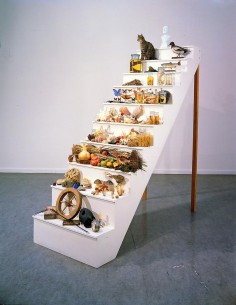Mark Dion
Scala Naturae

source: socks-studio
American conceptual artist, Mark Dion (1961, -) investigates the distinction between scientific methods and subjective influences, between fact and fiction, science and art, natural and artificial. Interested in the ways politics and ideologies shape our understanding of knowledge, the artist visually displays systems of information and classification, appropriating or imitating scientific or historical methods of collecting, ordering and exhibiting objects, such as historical cabinets of curiosities or antiquarian finds.
.
.
.
.
.
.
.
source: columbiaedu
Mark Dion’s first project for the LeRoy Neiman Center, Scala Natura, is the artist’s play on the notion of a hierarchy of life forms running through the canon of western philosophy. His visual chart borrows widely from the history of western image-making and scientific illustration. Dion playfully adds a row of objects of industry, art and culture to the final row of the chart, displacing humans from their position at the apex of the great chain.
For his second project, Hunting Standards, Dion collaborated with Nathan Catlin (MFA ’12) to create a portfolio of four banner-like images that illustrate both the empathy and irony of hunting. Through The Fox, The Boar, The Deer, and The Rabbit, he provides a visual commentary that addresses “hunting as a cultural practice that is rich in traditions, passionately pursued and highly controversial.”
Mark Dion was born in New Bedford, Massachusetts in 1961. He earned a BFA in 1986 and an honorary doctorate in 2003 from the University of Hartford School of Art, Connecticut, as well as an MFA from School of Visual Arts, New York in 1986. Dion has participated in many solo and group exhibitions and his work is represented in the collections of national and international museums. A notable commissioned work is his permanent outdoor installation and learning lab at the Olympic Sculpture Park, made for the Seattle Art Museum. Dion has often focused his artistic investigations on the complex history of the representation of nature, the practice of archeology and the culture of collecting. The forms of his projects are diverse and include architectural scale public works, sculpture, drawing, printmaking and photography.
.
.
.
.
.
.
.
source: tanyabonakdargallery
Since the early 1990s, Mark Dion has examined the ways in which dominant ideologies and public institutions shape our understanding of history, knowledge, and the natural world. Appropriating archaeological and other scientific methods of collecting, ordering, and exhibiting objects, the artist creates works that address distinctions between objective scientific methods and subjective influences. By locating the roots of environmental politics and public policy in the construction of knowledge about nature, Dion questions the authoritative role of the scientific voice in contemporary society.
Born in Massachusetts in 1961, Dion currently lives in New York City. He received a BFA and an honorary doctorate from the University of Hartford School of Art, Connecticut in 1986 and 2003, respectively. He also studied at the School of Visual Arts in New York from 1982-84, and participated in the Whitney Museum of American Art’s Independent Study Program from 1984-85. He has received numerous awards, including the ninth annual Larry Aldrich Foundation Award (2001) and the Smithsonian American Art Museum’s Lucida Art Award (2008).
Throughout the past two decades, his work has been the subject of major exhibitions worldwide. Notable solo exhibitions include The Macabre Treasury at Museum Het Domein in Sittard, The Netherlands, (2013), Oceanomania: Souvenirs of Mysterious Seas at Musée Océanographique de Monaco and Nouveau Musée National de Monaco / Villa Paloma in Monaco (2011), The Marvelous Museum: A Mark Dion Project at Oakland Museum of California (2010-11), Systema Metropolis at Natural History Museum, London (2007), The South Florida Wildlife Rescue Unit at Miami Art Museum (2006), Rescue Archaeology, a project for the Museum of Modern Art (2004), and his renowned Tate Thames Dig at the Tate Gallery in London (1999).
In 2012, his work was included in dOCUMENTA 13, curated by Carolyn Christov-Bakargiev in Kassel, Germany, and has also been exhibited at MoMA PS1 in New York, Guggenheim Bilbao in Spain, Minneapolis Institute of Art in Minnesota, Arp Museum Bahnhof Rolandseck in Remagen, Germany, and Kunsthaus Graz in Austria.
The artist has also completed numerous public commissions during his career, which include Den, a site-specific installation for the National Tourist Routes in Norway (2012), An Archaeology of Knowledge for John Hopkins University (2012), and Ship in a Bottle for Port of Los Angeles Waterfront (2011).
His work can be found in the collections of the Metropolitan Museum of Art, New York, Tate Gallery, London, The Museum of Contemporary Art, Los Angeles, Museum of Modern Art in New York, Centre Georges Pompidou in Paris, Hamburger Kunsthalle in Germany, Harvard University Art Museums in Massachusetts, and the Israel Museum of Art in Jerusalem, among others.
Presently, he is a mentor at Columbia University in New York and co-director of Mildred’s Land, an innovative visual art education and residency program in Beach Lake, Pennsylvania. He lives with his wife, the artist Dana Sherwood in New York City and works worldwide.

